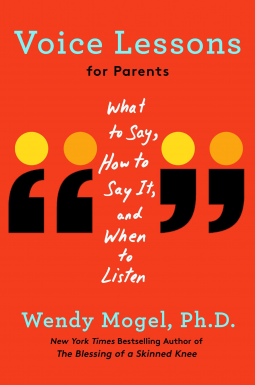Are You Really Saying What You Think You Are?
 In Voice Lessons for Parents: What to Say, How to Say It, and When to Listen, Wendy Mogel, Ph.D. provides a guide for parents to communicate with their children at all stages of development. Relying on three decades of experience working with parents and children as well as new research on neuroscience and biology, she provides guidance for all parents who may be struggling with communication in their homes.
In Voice Lessons for Parents: What to Say, How to Say It, and When to Listen, Wendy Mogel, Ph.D. provides a guide for parents to communicate with their children at all stages of development. Relying on three decades of experience working with parents and children as well as new research on neuroscience and biology, she provides guidance for all parents who may be struggling with communication in their homes.
She stresses that parents need to adapt their communication style to the child. Factors such as age, developmental level and even gender all play a role in determining how best to talk to a child. She points out that learning communication skills is an ongoing process and that parents should actively engage their children in conversation from infancy through adulthood. At its best, communication matches the cognitive development, interests and temperament of the child.
Parents do this instinctively with babies, and narrating everyday activities helps with speech and vocabulary development. Early conversations with children are about teaching communication skills, for example, when to talk and when to be silent. With older kids, being quiet and listening is more important than speaking. Model the behavior you want to see. Ignore your own technology in favor of in-person conversations.
Mogel discovered that techniques used by voice teachers can be valuable. Use of these techniques can influence how parents are heard, help parents hold their children’s attention and encourage engagement. She points out that the high-pitched, high-volume voice so many parents use when they are frustrated conveys a loss of control and is counter-productive, resulting in their children tuning them out. She encourages the use of vocal techniques and self awareness to promote better communication.
Studies show that male and female brains are different and develop skills at slightly different rates. These differences are spelled out with helpful suggestions on how to talk to children, using their age and gender as a guide. The author likens communicating with boys to working like an anthropologist, while with girls it is better to take an approach like a sociologist.
As children enter the teenage years, separation is developmentally appropriate. Though it may be difficult, when talking to them, parents need to remember these vocal techniques and that certain traits are common to teens (and temporary). More tips include: Ignore the attitude rather than take it personally; Use chores as a time to talk, and take full advantage of these moments.
The book rounds out with tips for talking to grandparents and avoiding/handling issues that frequently arise as well as tips for clear communication with nannies, teachers, coaches, etc. It also includes lists for parents of teens, such as: Things teens would like to say to parents; Ways to make teens feel loved; Things that parents don’t need to worry about; and Advice to parents.
Voice Lessons reinforces the importance of communication in family life. It not only addresses talking to kids, but also acknowledges that moms and dads have difference approaches and that’s okay. The author reminds parents to model appropriate communication with their partners, pointing out that kids watch how adults act and often learn more from that than what they are told.
